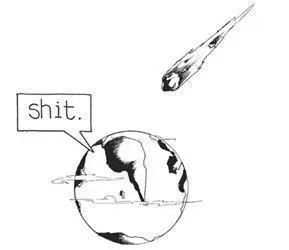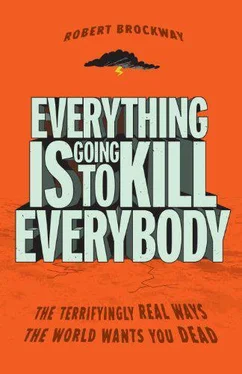Asteroids, radiation, frigid vacuums, and hostile aliens—let’s face it: space sucks, sometimes literally. Space doesn’t bring you flowers, or nurture abandoned puppies back to health. Space doesn’t provide delicious sandwiches at the company picnic or help old ladies across the street. It doesn’t do one damn nice thing for you; it basically just plots your death from the abyssal void of nothingness. Sinister threats from outer space may seem like science fiction to you, but it’s only science fiction until it’s landing on your damn head . Also, if you really stop and think about it, there’s a lot more of space than there are of us.
My God… don’t… don’t look now, but I think it’s everywhere . Space has got us surrounded!
12. ASTEROIDS AND EXTINCTION-LEVEL EVENTS

AN EXTINCTION-LEVEL Event (ELE) is a massive die-off of the majority of life on our planet, and they often seem to be caused by a particularly devastating asteroid impact. It’s not exactly a subtle or mysterious phenomenon. In a nutshell: big rock, big explosion. There’s not much to do but die as hard asyou possibly can. When most people think of major meteor strikes, they typically think of distant prehistoric events, like the one that caused the extinction of the dinosaurs 65 million years ago when an asteroid roughly six miles in diameter struck the Earth at a place called Chicxulub, which we now call Mexico, and began the most dramatic extinction in history. (It was not the largest extinction period: That dubious honor falls to the Permian-Triassic extinction event. But while the P-Tr event killed off most of the world’s insects, the Chicxulub event managed to slay every single real live dragon at once, and that’s the kind of dramatic flair that squashing a trillion bugs just does not possess.) Because we associate ELEs with such disasters in the long-distant past, the tendency is to think that catastrophic asteroid strikes are strictly relegated to ancient history when, in reality, nothing could be further from the truth. Meteors hit the Earth like your dad hits the bottle every time you disappoint him, which is to say very often, and very, very hard.
For example, see March 22, 2008, when a one-thousand-foot diameter asteroid passed within four hundred thousand miles of Earth—missing us by only six hours. To us, numbers like four hundred thousand seem vast, but in terms of space travel that’s basically like being in Earth’s pocket, and while missing something by six hours may seem like a lot to you, in astronomical terms that’s practically already inside of you: easing just the tip of its disaster member in to see how you like it before the full-fledged catastrophic shafting begins.
But even if it hadn’t missed us, Earth’s atmosphere typically protects us from a good deal of the debris that space is constantly trying to murder everybody with, and when a meteor enters the atmosphere it usually results in little more than a pleasant shooting star. Wishes are made, boys become real, and everybody learns a little lesson about love, right? Well, those dramatic shooting stars typically come from objects no bigger than a grain of sand, and if a grain of sand can light up the night sky—while simultaneously giving life to the hopes and dreams of optimistic children throughout the world—you can probably imagine what might happen when something a thousand feet across comes barreling through the atmosphere. (Hint: It ain’t granting wishes. Unless you’re wishing for a painful and fiery death.)
The Best Wish to Make upon a Falling Star
“I wish that was not a meteor about to kill everybody I love.”
If that asteroid does enter Earth’s atmosphere, a variety of things can go down, depending on its specific construction. The heavier bodies, like iron-laden rocks, are the ones most likely to actually impact the planet. That impact would throw up insane amounts of debris, release levels of destruction akin to several nuclear bombs, and leave a permanent terrain-changing impact crater for thousands of years. The more loosely constructed dust and ice asteroids, however, can’t always take the increased pressure from Earth’s atmosphere, and usually explode before impacting. That kind of sounds like the preferred scenario between the two: If it doesn’t hit, that’s like we’re getting off light, right? Not really. An object detonating in the air can actually do quite a bit more damage than a physical impact. The asteroid that missed us by a blink of an eye, for example, was a loosely constructed object; if it had entered our atmosphere, it would have detonated with a strength estimated at seven to eight hundred megatons. That’s about fifteen times the strength of the largest nuclear blast ever recorded! With that in mind, it’s probably safe to say that if a medium- to large-sized asteroid ever does make it through the atmosphere, we’re all pretty well fucked, because our best-case scenario in that situation is for the meteor to hit us so hard that it changes the very Earth itself. It gets a little hard to be optimistic when that kind of destruction is the most you can hope for. But if you think you can still see a bright side in all of this, be careful; it could just be a blinding flash from the largest explosion in history.
Unfortunately, if an asteroid is on a direct collision course with Earth, that very fact makes it less likely we’ll be able to see it until it’s far too late. Typically, we track asteroids by virtue of their movement parallel to us. But when they’re coming right for us, we can’t see them moving. They just look like beautiful, harmless specks of light. But even more worrisome are the asteroids already inside Earth’s orbital path—the ones whose path the Earth is intersecting with regularly, the ones closest to us, the ones most likely to hit; we can’t see those asteroids because they’re so close to us that they’re backlit by the sun. Remember the old campfire horror story about the babysitter trying to trace the threatening phone calls she’s been receiving? Well, that babysitter is us, and that serial killer is the asteroids, and good lord! I—I hate to break it to you, but… those phone calls are coming from inside the house .
Things You’ll Have Time to Say Between Noticing an Incoming Meteor and Death
• “I alw—”
• “Get u—”
• “Oh go—”
• “Whatthefuckisthat?”
To give us a better shot at avoiding secret, invisible, flaming space death, a team of researchers in Canada is launching a small satellite telescope to help us spot these near-orbit asteroids better, but it’s a low-budget venture and it could do only so much. And while something is always better than nothing, keep in mind that there are more than five thousand asteroids dangerously close to Earth that have already been discovered using just our meager existing technology—it’s kind of hard to get stoked about the mere possibility of the potential to maybe spot a few more. Launching a satellite to slightly extend our sight range is like wearing a bulletproof vest when more than five thousand guns are pointing at you—yes, a few of those bullets are gonna be stopped, but any way you cut it, somebody’s winding up as meat Jell-O in this situation, and we’re a planet-sized target.
But hey, don’t worry, the government is totally on this one: A more official (well, more official than Canada anyway) approach is already under way. The U.S. Congress has introduced the NEO Preparedness Act, a bill mandating that we create a special program called the Office of Potentially Hazardous Near-Earth Object Preparedness, which would develop the technology to track 90 percent of all near-earth objects (NEOs), even those as small as 140 meters, by the year 2020. You better believe NASA’s on that shit too; they’ve decided that we would need a much larger version of Canada’s tracking satellite in place, preferably near Venus’s orbit, to achieve this Congress-mandated goal. Unfortunately, it would cost about 1.1 billion dollars for fifteen years of operation, and that’s just not in NASA’s budget. Also unfortunately, Congress is far too busy asking if baseball players are really as strong as they seem and trying to choke bankers with wads of cash to grant more funds to such trifling matters as the avoidance of space bullets, so they won’t give NASA the money. NASA scientists have stated that they intend to get to work on pursuing other, less costly plans, but seeing as how Congress is probably scheduling appointments to review whether wrestling is real and appointing a committee to decide exactly how awesome the last season of LOST is going to be, NASA probably shouldn’t hold their breath on this whole “averting Armageddon” thing.
Читать дальше













